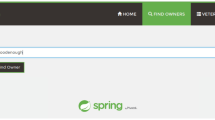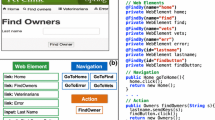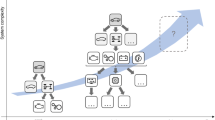Abstract
The development of accessible Web software is complicated for several reasons. Though some of them are technological, the majority are related with the need to compose different and, many times, unrelated design concerns which may be functional as in the case of most of the specific application’s requirements, or non-functional such as Accessibility itself. In this paper, we present a novel approach to conceive, design and develop Accessible Web applications in an aspect-oriented manner. In order to reach our goal, we provide some modeling techniques that we specifically developed for handling the non-functional, generic and crosscutting characteristics of the Accessibility concerns. Specifically, we have enriched User Interaction Diagrams with integration points, which are used to reason and document Accessibility for activity modeling during user interface design. Then by instantiating a Softgoal Interdependency Graph template with association tables, we work on an abstract interface model (composed by ontology widgets) to obtain a concrete and accessible interface model for the Web application being developed. We use a real application example to illustrate our ideas and point out the advantages of a clear separation of concerns throughout the development life-cycle.
Similar content being viewed by others
References
Baumeister, H., Knapp, A., Koch, N., Zhang, G.: Modelling adaptivity with aspects. In ICWE (2005) doi:10.1007/11531371_53
Baniassad, E.L.A., Clements, P.C., Araújo, J., Moreira, A., Rashid, A., Tekinerdoga, B.: Discovering early aspects. IEEE Softw 23(1), 61–70 (2006)
Baxley, B.: Universal model of a user interface. DUX (2003) doi:10.1145/997078.997090
Casteleyn, S., Fiala, Z., Houben, G-J., van der Sluijs, K.: Considering additional adaptation concerns in the design of web applications. AH (2006) doi:10.1007/11768012_28
Centeno, V., Kloos, C., Gaedke, M., Nussbaumer, M.: Web composition with WCAG in mind. W4A (2005) doi:10.1145/1061811.1061819
Ceri, S., Brambilla, M., Fraternali, P.: The history of WebML lessons learned from 10years of model-driven development of web applications. Concept Model (2009). doi:10.1007/978-3-642-02463-4_15
Chung, L., Nixon, B.A., Yu, E., Mylopoulos, J.: Non-functional requirements in software engineering. Kluwer Academic Publishers, Boston (2000)
Chung, L., Supakkul, S.: Representing FRs and NFRs: a goal-oriented and use case driven approach. SERA (2004) doi:10.1007/11668855_3
Troyer, D., Casteleyn, S., Plessers, P.W.S.D.M.: Web semantics design method. In: Rossi, G., Pastor, O., Schwabe, D., Olsina, L. (eds.) Web engineering: modeling and implementing web applications, pp. 303–351. Springer-Verlag, London (2008)
Filman, R., Elrad, T., Clarke, S., Aksit, M.: Aspect-oriented software development. Addison-Wesley, Vancouver (2004)
Hoffman, D., Grivel, E., Battle, L.: Designing software architectures to facilitate accessible web applications. IBM Syst J 44(3), 467–484 (2005)
Houben, G-J., van der Sluijs, K., Barna, P., Broekstra, J., Casteleyn, S., Fiala, Z., Fransincar, F. Hera: In: Rossi, G., Pastor, O., Schwabe, D., Olsina, L. (eds.) Web engineering: modeling and implementing web applications, pp. 163–302. Springer-Verlag, London (2008)
Kim, Y.B.: Accessibility and usability of user-centric web interaction with a unified-ubiquitous name-based directory service. World Wide Web J 13(1–2), 105–120 (2010)
Koch, N., Knapp, A., Zhang, G., Baumeister, H.: UML-based web engineering: an approach based on standards. In: Rossi, G., Pastor, O., Schwabe, D., Olsina, L. (eds.) Web engineering: modeling and implementing web applications, pp. 157–191. Springer-Verlag, London (2008)
Larson, J.: Interactive software: tools for building interactive user interfaces. Prentice Hall, NJ (1992)
Martín, A., Cechich, A., Gordillo, S., Rossi, G.: A Three-layered approach to model web accessibility for blind users. LA-WEB (2007) doi:10.1109/LA-WEB.2007.56
Martín, A., Cechich, A., Rossi, G.: Comparing approaches to web accessibility assessment. In: Calero, C., Moraga, M.Á., Piattini, M. (eds.) Handbook of research on web information systems quality, pp. 181–205. Information Science Reference, Hershey (2008)
Moreira, A., Araújo, J., Rashid, A.: A concern-oriented requirements engineering model. CAiSE (2005) doi:10.1007/11431855_21
Niederhausen, M., Fiala, Z., Kopcsek, N., Meissner, K.: Web software evolution by aspect-oriented adaptation engineering. WSE (2007) doi:10.1109/WSE.2007.4380237
PAS 78. Publicly Available Specification: A Guide to Good Practice in Commissioning Accessible Websites, ICS 35.240.30. Disability Rights Commission (DRC) http://shop.bsigroup.com/en/ProductDetail/?pid=000000000030129227 (2006). Accessed 25 January 2010.
Plessers, P., Casteleyn, S., Yesilada, Y., De Troyer, O., Stevens, R., Harper, S., Goble C.: Accessibility: a web engineering approach. WWW (2005) doi:10.1145/1060745.1060799
Rossi, G., Schwabe, D.: Modeling and implementing web applicactions with OOHDM. In: Rossi, G., Pastor, O., Schwabe, D., Olsina, L. (eds.) Web engineering: modeling and implementing web applications, pp. 109–155. Springer-Verlag, London (2008)
Schauerhuber, A., Wimmer M., Schwinger, W., Kapsammer, E., Retschitzegger, W.: Aspect-oriented modeling of ubiquitous web applications: the aspectWebML approach. ECBS MBD (2007) doi:10.1109/ECBS.2007.20
Section 508. Electronic and Information Technology Accessibility Standards http://www.access-board.gov/sec508/508standards.pdf (2000). Accessed 25 January 2010
Sommerville, I.: Software engineering, 8th edn. Pearson Education Limited, Harlow (2007)
Vilain, P., Schwabe, D., Sieckenius de Souza, C.: A diagrammatic tool for representing user interaction in UML. UML (2000) doi:10.1007/3-540-40011-7_10
W3C: Web Content Accessibility Guidelines 1.0. (WCAG 1.0). http://www.w3.org/TR/WAI-WEBCONTENT/ (1999). Accessed 15 April 2009
W3C: Web Content Accessibility Guidelines 2.0 (WCAG 2.0). http://www.w3.org/TR/WCAG20/ (2008). Accessed 25 January 2010
W3C: HTML Techniques for Web Content Accessibility Guidelines 1.0. http://www.w3.org/TR/WCAG10-HTML-TECHS/ (2000). Accessed 15 April 2009
W3C-WAI: Comparison of WCAG 1.0 Checkpoints to WCAG 2.0. http://www.w3.org/WAI/WCAG20/from10/comparison/ (2008). Accessed 25 January 2010.
Yesilada, Y., Harper, S., Goble, G., Stevens, R.: DANTE: annotation and transformation of web pages for visually impaired users. WWW (2004) doi.acm.org/10.1145/1013367.1013540
Zimmermann, G., Vanderheiden, G.: Accessible design and testing in the application development process: considerations for an integrated approach. Univ. Access Inf. Soc. 7(1–2), 117–128 (2008)
Author information
Authors and Affiliations
Corresponding author
Rights and permissions
About this article
Cite this article
Martín, A., Rossi, G., Cechich, A. et al. Engineering Accessible Web Applications. An Aspect-Oriented Approach. World Wide Web 13, 419–440 (2010). https://doi.org/10.1007/s11280-010-0091-3
Received:
Revised:
Accepted:
Published:
Issue Date:
DOI: https://doi.org/10.1007/s11280-010-0091-3




